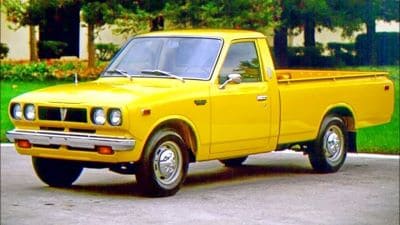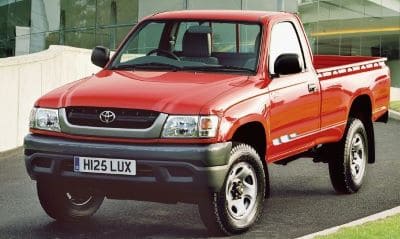UK Car Guide ›› Pickups ›› Toyota Hilux
Toyota Hi Lux Models
So far, eight generations of Toyota Hiluxes have earned a remarkable reputation for being reliable and dependable light-duty vehicles.
In celebration of the achievement, the information and data in this chronicle spotlights the history of the Hilux and timeline of the variants from 1968 through to the present day.
The Heritage and History of Toyota Hilux
How many pickup truck models can you name that have survived the extreme environments of the Arctic and Antarctic?
Put another way:
It's difficult to tarnish the tried and tested credentials of these ultra-tough commercial vehicles. To prove a point, they have already sold over 19 million units and it's been voted the most popular pick-up in Europe.
These legendary vehicles have been tackling the toughest of terrains since the first-generation RN10 short-wheelbase Toyotas hit the roads in 1968. This was how the fun started and they haven't looked back since!
Is it Hilux, Hi Lux, or Hi-Lux?
Let's go back to the early days. In fact, Toyota stylised it as the HiLux. But, it adopts the Hi-Lux name tag from a historical standpoint.
No matter which one, the Japanese automobile manufacturer Toyota produces and markets this series of pickup trucks.
To make it even easier, the official classification of the Toyota Hilux is either a pickup truck or one of the chassis cab "half truck" variants (e.g. configured with various body styles).
Hilux Timeline: 1968 to 2024
1968: First Generation
The production of the first-ever Hilux began in March 1968. The RN10 was a short-wheelbase pickup with a 1.5 litre straight-four engine that could generate a maximum output of 77 PS (PferdStarke is the universal metric measurement of horsepower).
But, even though Toyota conceived it, Hino Motors (a brand with headquarters in Tokyo) was the company that actually developed and manufactured the vehicle that eventually replaced the Hino Briska.
The RN10 2-door truck received some modifications to the engine in 1971. Upgrading the 1.5-litre to a 1.6 L inline-four engine meant it could reach a top speed of 130 km/h (81 mph).
1972: Second Generation
The partnership released the next generation Hilux in 1973 (the RN20). The "RokeHi" (the compound word from "Rocket Hilux") had a few more comforts inside the cabin for the driver. This is the version that finally reached markets in the United Kingdom.
 In fact, a "long bed" pickup had been available since 1969.
In fact, a "long bed" pickup had been available since 1969.
But, the extended loading bed of the RN20 measuring 2.25 metres long (7.4 feet) became a new option for the market in North America.
Moving on...
In 1975, the Hilux received its first radical redesign. It became larger and there were improvements made to the standard equipment.
This is when North America received the bigger Toyota R family gasoline automobile engine (2.2 litre) and the Sport Rally Five-Speed (SR5) trim package.
It was the same period when a five-speed stick shift manual transmission became an option. Nonetheless, they phased out the Hilux name in North America and they chose to use the "Truck" instead.
Pro Tip: Check out our automotive blog post that contains a list of cars named after states and cities, with a brief anecdote about the relationship between the locality and the car named after it.
1978: Third Generation
The introduction of a redesigned Hilux in 1978 came with a 4WD variant the following year. It wasn't a lot bigger. But it did have wider front and rear tracks.
It also received changes to the front suspension. They got rid of the coil springs and fitted a torsion spring suspension to complement the independent double wishbone layout.
In case you were wondering:
This variant also featured some of the common technology with the four-wheel drive Toyota Land Cruiser until 1983. Even though production of the 4WD models had already stopped, they carried on producing some of the 2WD models.
Toyota Enters SUV Market in North America
Toyota set up a special agreement with the American motorhome manufacturer Winnebago Industries, and others, in 1981. This helped Toyota Motor Corporation break into the lucrative SUV market in the northern US. The collaboration resulted in the production of:
- Trekker Winnebago
- Toyota Wolverine
- Griffith Trailblazer
The Hilux 4x4 recreation vehicle cab and chassis - and a rear section made from fibreglass - were common among all three SUVs. Further developments eventually led to the production of the Toyota 4Runner SUV in 1984.
1983: Fourth Generation
The next redesign completed the introduction of the 2-door Xtracab extended cab. The double cab pickup option resulted in six extra inches of storage space behind the front seats.
Even though they were still using the carbureted 22R engine, they also introduced the fuel injected 22R-E engine in 1984. The 2L and the turbocharged 2L-T were the two offerings for the diesel-engined versions.
The End of Solid Front Axles
Most markets saw the slow demise of the solid front axle from 1985. But, it remained in the 5th generation Toyota Hilux 4x4 LN106 model through to 1997.
Apart from a new front grille, the 1987 truck model received further redesigns to the interior and exterior, including:
- A one-piece front bumper.
- High door panels.
- Grey, red, blue, or brown steering wheels (previously black).
- Colour-matching radio bezel.
- Streamlined outside door mirrors.
Keen buyers had to wait until 1988 for the V6 engine. This was also the period when Toyota introduced a new generation Hilux pick-up to the major international markets, especially Australia, the United Kingdom, and North America.
1988: Fifth Generation
The late eighties saw further changes to the length of the wheelbase and the rust-prone cargo box walls.
 Toyota stretched it to 309 centimetres (122 inches) for drivers who wanted a longer option.
Toyota stretched it to 309 centimetres (122 inches) for drivers who wanted a longer option.
In fact, 1988 was also good for the V6 Xtracab SR5 - winning the "Motor Trend" magazine Truck of the Year award.
Further development of Toyota's extended cab pickups now offered more space behind the front seats.
Optional "jump-seats" for any rear passengers became a feature more in tune with many of its rivals, such as the Ford F-Series (eighth generation).
Note: This generation also brought about the discontinuation of the Hilux line in North America. Instead, they marketed as the "Toyota Pickup" until the Toyota Tacoma pickup truck replaced it in 1995. The fifth generation Hilux became available in 2WD and 4WD in the United Kingdom from 1989.
1997: Sixth Generation
The minor design changes for the 1997 update accompanied additional engine choices. Toyota unveiled the major Hilux facelift for the 2002 model year.
Toyota stopped producing the Hilux truck for the Japanese market in 2005. Thus, it ended up being the last generation of Hiluxes built in Japan.
Motorists in Thailand saw a variant of the Hilux, called the Sport Rider. It was a mid-size SUV loosely based on the regular styling and underpinnings
Pro Tip: In 2000, UK VAT for Double Cabs became reclaimable after Toyota increased the payloads of the Single and Double Cab models.
2004: Seventh Generation
Some owners in South East Asia will know the seventh-generation Hilux as the AN10, AN20, or AN30. They were part of Toyota's "Innovative International Multi-purpose Vehicle" platform from 2004. These 3 pickup truck body variants became available as the:
- Two-door Single Cab (IMV1)
- Two-door Xtra Cab (IMV2)
- Four-door Double Cab (IMV3).
The Smart Cab was a 4-door model introduced in the Autumn of 2008. It had hidden rear clamshell doors, also called "suicide doors".
The birth of the Toyota Innova (AN40), as well as the Toyota Fortuner (AN50/AN60) also came about from the same IMV program.
Using a Ladder Frame Chassis
One benefit of using a body-on-frame construction is a significant increase in torsional stiffness. It actually became about 45% stiffer in the seventh generation Hilux. Plus, using a unified inner frame means there are less welded joints.
The use of a new double wishbone front suspension (instead of a front strut) resulted in what many Toyota owners were calling "better stability and ride comfort".
Toyota Hilux Model Sizes
The seventh generation Hilux model is much bigger than the previous generation. The 2005 double cab is 40 cm (15.7 inches) longer and 4.5 cm (1.8 inches) wider. The deck is also 16.5 cm (6.5 inches) longer and about 5 cm (2.0 inches) wider and taller.
Pro Tip: Another section compares how different makes and models of pickup trucks meet the grade for specifications, pricing, and for tax efficiency.
2015: Eighth Generation
Toyota introduced the eighth-generation Hilux in Thailand and Australia in May 2015. The moniker became the "Hilux Revo" in some Asian markets, especially Cambodia, Thailand, and Pakistan.
After releasing the new pickup trucks in a multitude of other markets in 2015, including the Philippines and Brazil, it finally reached South Africa the following year.
Features of the New Hilux Pickup
The "Toyota Keen Look" design language has become a key feature that many of its competitors also offer as standard, such as the Ford Ranger models and the new Volkswagen Amarok.
For example:
The slim headlight shape has optional projector headlights and light-emitting diode (LED) "auto" daytime running lights.
There are more "car-like" designs inside too, with new stylish AC vents and centre fascia. Plus, the optional autonomous emergency braking system (AEB) is now available from the latest Hilux for the first time in its long and illustrious lifetime.
2023: Hilux Champ
The Toyota Hilux Champ has been on sale in Thailand since November 2023. It is available as either a two-door pickup truck or a chassis cab based on the IMV platform (e.g. shared with the Hilux).
You might also enjoy reading about...
Check out our pickup trucks comparison guide for a list of the key features and technical specifications available in the new models reaching the showroom forecourts this year.